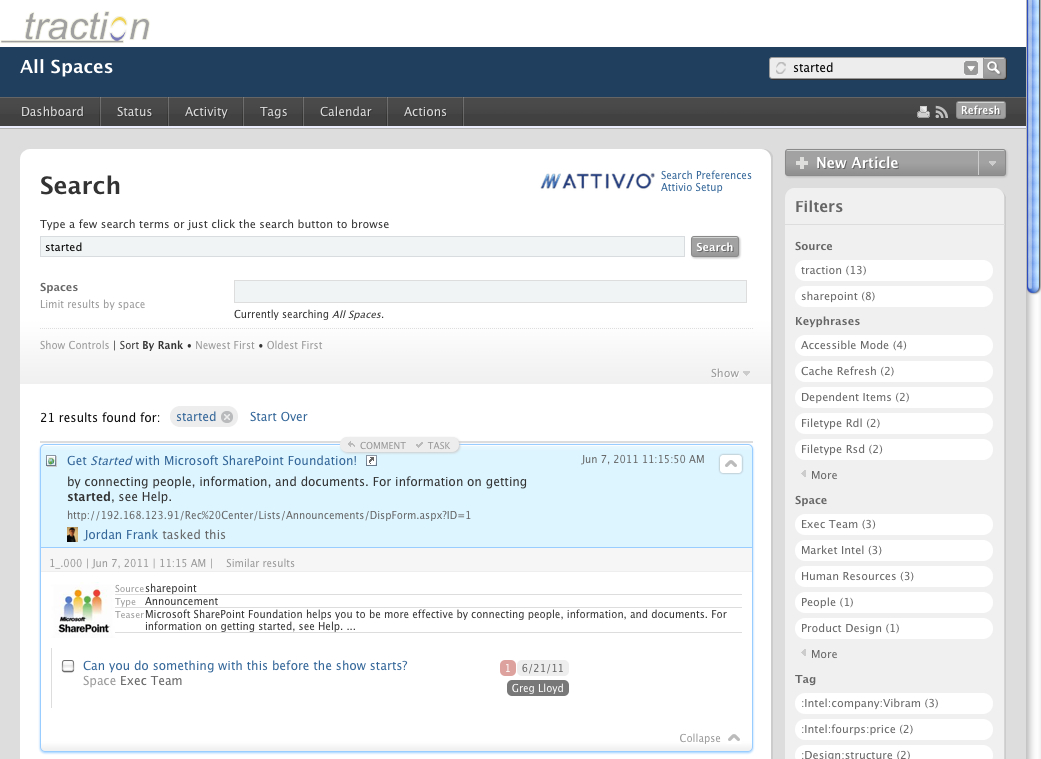Extending the fabric of work, or How to Be Emergent
 I enjoyed reading Dion Hincliffe's Putting Social Business to Work and G+ discussion led by Luis Suarez on Laurie Buczek's The Big Failure of Enterprise 2.0 Social Business. I agree that top down - and isolated - Social Business parallels the faults of top down - and isolated - Knowledge Management. I like Laurie's analysis and recommendations, including her top level: "Make social tools part of the collaborative workflow." This is good for both social business and knowledge management. The question is: how to extend the fabric of work?
I enjoyed reading Dion Hincliffe's Putting Social Business to Work and G+ discussion led by Luis Suarez on Laurie Buczek's The Big Failure of Enterprise 2.0 Social Business. I agree that top down - and isolated - Social Business parallels the faults of top down - and isolated - Knowledge Management. I like Laurie's analysis and recommendations, including her top level: "Make social tools part of the collaborative workflow." This is good for both social business and knowledge management. The question is: how to extend the fabric of work?
An edict from management or prayer from internal evangelist to "be social" is often translated: "how many hours a week?" and "instead of doing what?" A top down Knowledge Management edict: "share what you know" turns into a empty Friday afternoon exercise that's soon abandoned.
In both cases bottom-up capture of conversations, actions, responses to routine or exceptional issues, and human actions in context is a much better way to deliver what knowledge management and social business promise.
This includes free-form accidental discoveries and introductions to folk throughout the organization who aren't usually involved or aware of what others are doing. In my opinion, emergent and unpredictable value that advocates of Enterprise 2.0 promise is an outgrowth of making work more open, observable and discoverable. It's also critical to make work easier, more effective and more enjoyable. Build on that rather than adding overhead and waiting for people to jump into an activity they see as optional and divorced from their contribution to the success of their business.
Enterprise 2.0 systems like Traction TeamPage are really good at capturing conversation in context, tracking action and linking what people do or say to their profiles and vice versa. But it's difficult to make work done within siloed systems of record - document repositories, ERP, CRM - visible and actionable. Opening up siloed discussion in each system of record makes matters worse, not better.
Sharing activity streams across systems of record is one way to avoid the siloed discussion trap. But limiting visibility of work to activity streams opens a new problems: activity stream overload. If you think following hundreds or thousands of people on Twitter can be frustrating, wait until you hear what you get from raw streams from line of business applications. A stream of "What I had for lunch" tweets is thrilling compared to a stream of Documentum check-in notices and decontextualized status.
I believe that the best solution will include permission-aware search than spans activity streams and systems of record to make documents, individual email messages, SQL database records from CAD/CAE or other line of business systems actionable, social objects. What's important is the ability to connect people, records, conversation and action in the context of core business activities like product development, sales, support, and coordinated work with customers, suppliers and partners. This should include daily routine, exceptions, and new discoveries.
At E2.0 Boston, Traction Software announced and showed TeamPage and Attivio's Social Enterprise Web technology used to search, discuss, tag, task, and share live structured data or unstructured content in external systems of record including Microsoft SharePoint, EMC Documentum, Microsoft Exchange, File servers, SQL databases, intranets, and the public Web.
A question found in a customer email stored in Exchange, an issue with a new drug application filed in Documentum, a fact in a legacy document stored in SharePoint or a File server S: drive, a record in an SQL database can all be discovered, discussed, tagged, and tasked for follow-up action in TeamPage without converting or importing data from its original source. Systems of record look and act like they are part of the same permission-aware TeamPage fabric used for collaboration, communication, and action tracking in the flow of daily work.
Large companies have enormous IT teams promising enterprise-wide search and collaboration with roadmaps stretching years into the future and budgets of seven to ten figures or more. Traction TeamPage and Social Enterprise Web capabilities are packaged and priced to make deep, permission aware search and collaboration crossing many sources simple to deploy, manage, and use. This is a game changer for small to mid-size businesses who don't find complex, multilayered enterprise architectures manageable or affordable. This is also a great option for teams in large companies who want to get their work done now, working over existing systems of record.
You'll hear more about this soon [or contact us to learn more now]. Making systems of record look and act more like the Web - including scalable, permission aware search - extends the fabric of work in context for external and internal stakeholders.
Related
- 21 June 2011 | Traction Software Introduces Social Enterprise Web
- Alcoa Fastening Systems - Groundswell 2011 Award Nomination for Collaboration
- Introducing Online Workplaces - Greg's notes on Larry Cannell's July 2011 Webinar - Online workplace
- Fixing Enterprise Search - spanning systems of record
- Intertwingled Work - connecting work across multiple sources
- Knowledge Fishing vs. Knowledge Farming - Grass roots knowledge management
- 20 June 2005 | Supernova | Why Can't a Business Work More Like the Web?
On G+ see
Luis Suarez - 24 Aug 2011
Dion Hinchcliffe - 24 Aug 2011
Greg Lloyd - 24 Aug 2011

 I18N ERROR: @tsiskin#footer_RSS_Feed
I18N ERROR: @tsiskin#footer_RSS_Feed